Bacteria begin to form and multiply in the mouth shortly after birth. Almost immediately, our life-long battle against plaque begins. Plaque is composed mostly of bacteria, in combination with saliva, food and fluid secreted by the gums. the heaviest concentration of plaque tends to be at the point where the teeth meet the gums and between the teeth.
If not removed daily, the bacteria in plaque multiply into colonies. In time, unremoved plaque hardens into tartar, a tough gritty deposit that gives new plaque a rough surface to which it can cling. Tartar can only be removed by a dentist or dental hygienist.
Specific types of bacteria in plaque produce substances toxic to the gums and bones that hold the teeth in place. If plaque is allowed to grow, an inflammation of the gum called gingivitis occurs. As periodontal disease progresses, gums begin to pull away and recede from the teeth.Pockets of bacteria form and deepen, gradually reaching and destroying the bone that anchors the teeth. In this advanced stage known as periodontitis, teeth may be lost without prompt treatment by a dentists.
You should make it a point to see a dentist for a check up and professional cleaning at least twice a year, more often if recommended. The number of essential visits depends on the individual. Some people, for an instance, form tartar at a faster rate and may need professional cleaning more often.
During a regular visit, plaque and tartar will be removed from the teeth and the dentist also will check for any signs that could be indicative of periodontal disease. Regular visits also give the dentist opportunity to treat various stages of periodontal disease, which develop with symptoms that are invisible or that would be missed by an untrained eye.
During checkups an instrument called a periodontal prove is used to determine if there is any breakdown in the attachment of the gums to the teeth or early development of pockets between the gums and teeth. The depth of the pockets is measured in millimeters with this thin metal instrument. Generally, up to three millimeters is considered normal.
Anything deeper may be an indication that plaque removal needs to be improved in a particular area of the mouth. X-rays are also taken to determine the condition of the bone.
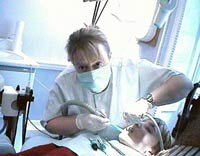 Do you have problems with bleeding gums, bad breath or stained teeth? Our dental hygienist Dee is trained in all aspects of oral health care, especially scaling and polishing. She can also provide the foundation for your preventative treatment by giving home care advice.
Do you have problems with bleeding gums, bad breath or stained teeth? Our dental hygienist Dee is trained in all aspects of oral health care, especially scaling and polishing. She can also provide the foundation for your preventative treatment by giving home care advice.


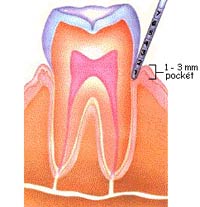 The gums have a healthy pink colour. Gum line hugs teeth tightly. No bleeding.
The gums have a healthy pink colour. Gum line hugs teeth tightly. No bleeding.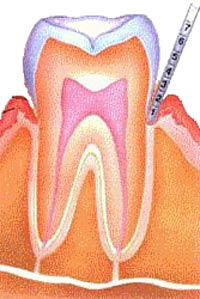 Gums bleed easily when you brush or when probed gently during examination ~ Gums are inflamed and sensitive to touch. Possible bad breath and bad taste. Gums between teeth may look bluish-red in color.
Gums bleed easily when you brush or when probed gently during examination ~ Gums are inflamed and sensitive to touch. Possible bad breath and bad taste. Gums between teeth may look bluish-red in color.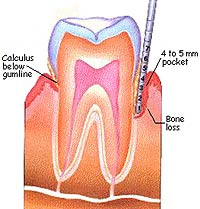 Gums may begin to pull away from the teeth. Bleeding, puffiness and inflammation more pronounced. Bad breath, bad taste, slight loss of bone horizontally on X-ray ~ Pockets of 4-5mm between teeth and gums in one or more areas of the mouth.
Gums may begin to pull away from the teeth. Bleeding, puffiness and inflammation more pronounced. Bad breath, bad taste, slight loss of bone horizontally on X-ray ~ Pockets of 4-5mm between teeth and gums in one or more areas of the mouth.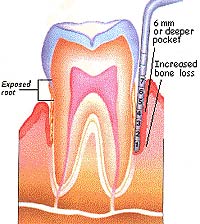 Gum boils or abscesses may develop. Teeth look longer as gums begin to recede. Front teeth may begin to drift, showing spaces, bad breath, bad taste. Both horizontal and angular bone loss on X-ray. Pockets between teeth and gum range from 4-6mm deep.
Gum boils or abscesses may develop. Teeth look longer as gums begin to recede. Front teeth may begin to drift, showing spaces, bad breath, bad taste. Both horizontal and angular bone loss on X-ray. Pockets between teeth and gum range from 4-6mm deep.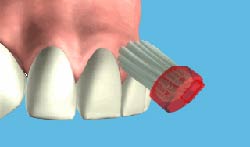 Place your toothbrush at a 45-degree angle against the gums.
Place your toothbrush at a 45-degree angle against the gums.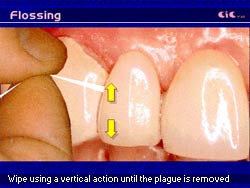 Break off about 18 inches of floss and wind most of it around one of your middle fingers.
Break off about 18 inches of floss and wind most of it around one of your middle fingers.